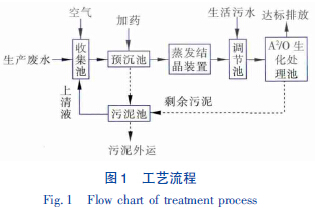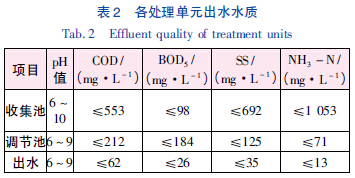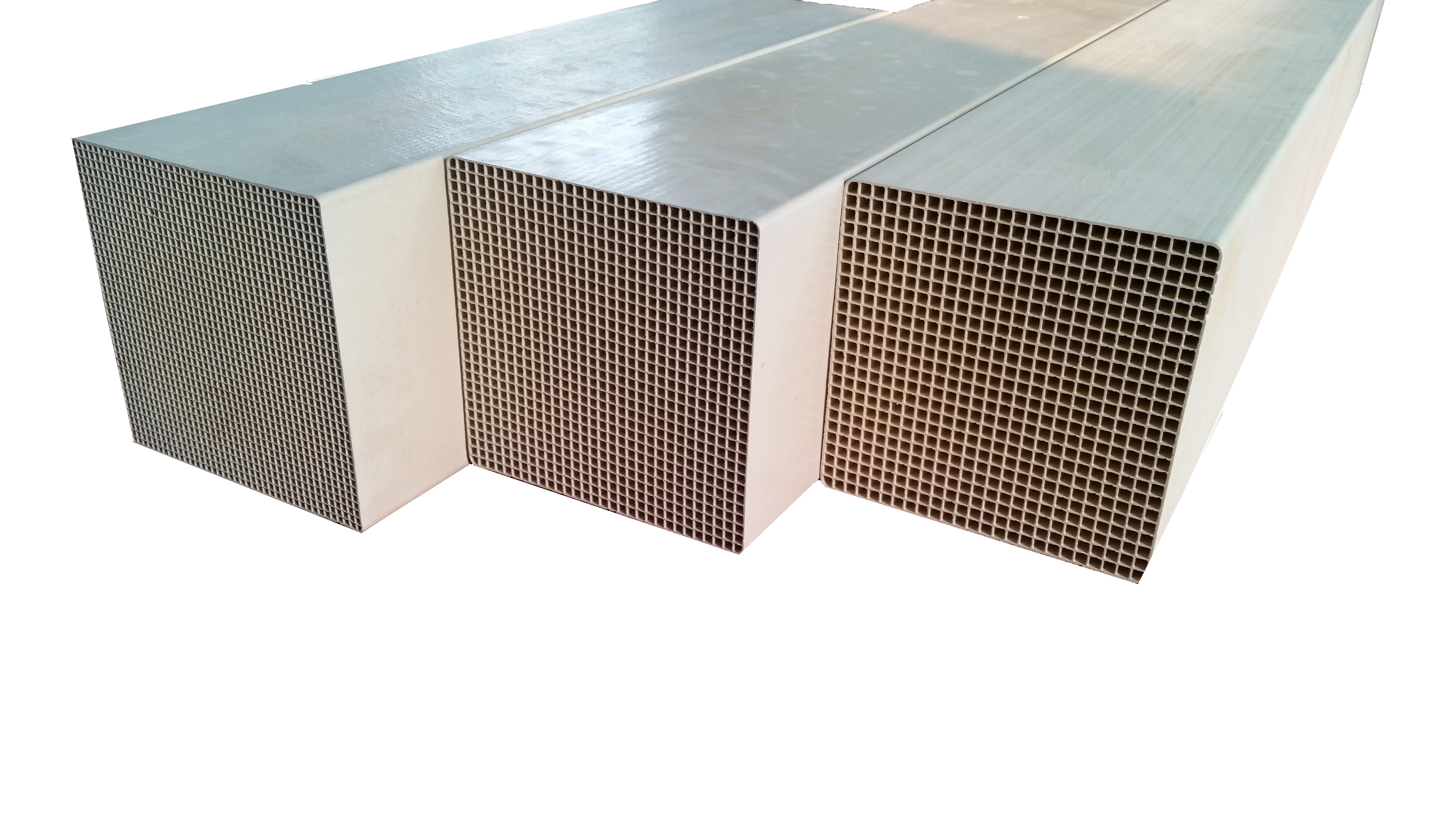On the Treatment Process of Wastewater from Denitration Catalyst Production
Publishdate:2018-08-31 Views:85
With the development of China's denitrification catalyst industry, the problem of wastewater treatment generated by it has become increasingly prominent. During the production process of denitration catalysts, high ammonia nitrogen wastewater will be generated. If left untreated and discharged into the external environment, it will lead to eutrophication of the water body and affect the ecological environment [1].
The wastewater from catalyst production mainly comes from ammonia washing tower wastewater, mold cleaning room wastewater, and some ground flushing water. The water quality of wastewater has the following characteristics [2]:
① The concentration of ammonia nitrogen in wastewater is relatively high, especially in the discharge of ammonia washing tower wastewater, which can reach over 1000mg/L;
② The ammonia washing tower (ammonia gas is absorbed by a 3% dilute sulfuric acid solution) has a high salt content in the wastewater;
③ The BOD5 value of production wastewater is low, and the biodegradability of wastewater is poor;
④ The quality of water from different sources varies greatly, and the amount of water produced during different production stages varies greatly.
1 Project Overview
The denitrification catalyst factory under a certain provincial energy group is a professional enterprise that produces denitrification catalysts, with an annual output of 6000 tons of SCR denitrification catalysts. The existing wastewater treatment station adopts evaporative crystallization for pre-treatment, and combines A2/O biochemical combination process to treat production wastewater and domestic wastewater in the factory area. After the effluent quality meets the level standard of the Comprehensive Wastewater Discharge Standard (GB8978-1996), it is directly discharged.
1.1 Design scale
This project mainly treats production wastewater and domestic sewage. Intermittent discharge of production wastewater, with an average water volume of about 2m3/h. The average amount of domestic sewage is about 1m3/h, and the comprehensive design wastewater treatment capacity is 72m3/d.
1.2 Design inlet and outlet water quality
The specific design of inlet and outlet water quality is shown in Table 1 (only the main pollution indicators are selected as the design indicators).

From Table 1, it can be seen that the wastewater from the production of denitrification catalysts has characteristics such as high ammonia nitrogen content, low BOD5 value, and poor biodegradability.
2. Process flow and characteristics
2.1 Process flow
After the ammonia washing tower, mold cleaning, and ground flushing wastewater are mixed in the collection tank, the mixed wastewater is aerated and adjusted according to the liquid level; After adjustment, the wastewater is pumped up and enters the pre settling tank. After adding chemicals, suspended solids and some ammonia nitrogen are removed from the wastewater through chemical precipitation; After adjusting the pH value of the effluent from the pre sedimentation tank, it is subjected to desalination pre-treatment through an evaporative crystallization device. The ammonium sulfate waste salt precipitated by crystallization is entrusted for treatment or comprehensive utilization. The effluent is mixed with domestic sewage in the regulating tank and lifted by a pump, and then processed through anaerobic, facultative, aerobic and other stages. Finally, the effluent meets the discharge standards. The sludge from each process section is discharged into the sludge tank, and the supernatant flows back. The sediment is regularly cleaned and transported out.
The process flow is shown in Figure 1.

2.2 Process characteristics
① Evaporative crystallization as a pre-treatment reduces the ammonia nitrogen and salt content in wastewater, greatly weakening its inhibitory effect on subsequent biological activity and improving the biochemical treatment effect.
② The use of evaporative crystallization as a method for removing ammonia nitrogen avoids the drawbacks of using breakpoint chlorination, which increases new sources of danger (chlorine or sodium hypochlorite), and air blowing, which generates new ammonia gas. At the same time, it greatly reduces the ammonia nitrogen load for subsequent biochemical treatment.
③ The introduction of domestic sewage has increased the BOD5 concentration of wastewater, enhanced its biodegradability, and ensured the subsequent biochemical treatment effect.
④ While improving the biodegradability of wastewater, it also treats domestic sewage, reducing investment in domestic sewage treatment facilities and achieving good economic benefits.
3 Main structures and equipment
① Collection Pool
Intermittent discharge of production wastewater, with an average water volume of about 2m3/h. Install one wastewater collection tank, using an underground reinforced concrete structure with an effective volume of 20m3 and an HRT of 10 hours. Set up 2 submersible pumps (1 for use and 1 for backup), with a single pump Q=2m3/h and H=100 kPa, and use a liquid level gauge to control the start and stop of the pumps. Plant compressed air is used for aeration regulation.
② Pre sedimentation tank
Install one pre sedimentation tank, using a semi underground reinforced concrete structure, in the form of a grid flocculation reaction horizontal sedimentation tank. The size of the pool body is 7m × 1.5m × 3.2m, with a surface load of 0.2m3/(m2 · h) (to ensure sedimentation efficiency and combine with site conditions, the design selection value is relatively low).
③ Evaporative crystallization device
Install one evaporative crystallization device with a processing capacity of 2 t/h and an external dimension of 6.5m × 6.0m × 15m, evaporation rate of 1.93 t/h, heating area of 136m2, steam consumption of 733 kg/h, steam utilization of residual steam from plant process, pressure of 0.3-0.5Pa (saturated steam). Adopting triple effect evaporation crystallization ammonium sulfate, and supporting all auxiliary equipment and materials in the evaporation crystallization system.
④ Regulating pool
Install one regulating pool, an underground reinforced concrete structure with an effective volume of 30m3 and an HRT of 10 hours. Set up 2 lifting water pumps (1 for use and 1 for backup), with a single Q=3m3/h and H=150 kPa.
⑤ A2/O biochemical treatment tank
Install one A2/O biochemical treatment tank with a size of 8.0m × 6.0m × 3.0m, reinforced concrete structure. Including anaerobic tank, facultative tank, aerobic tank, final sedimentation tank, clean water tank, equipped with aeration fan, mixed liquid reflux pump, sludge reflux pump, clean water pump, etc.
⑥ Sludge tank
Install one sludge tank with an underground reinforced concrete structure and an effective volume of 22.5m3. Main equipment: 2 sludge pumps (1 for use and 1 for backup), with a single Q=15m3/h and H=180 kPa.
⑦ Dosing and distribution room
The dosing and distribution room adopts a brick concrete structure, with 3 sets of dosing devices, and each set of flocculant, coagulant aid, and acid-base regulation dosing system.
4 Operation status
Since the commissioning and operation of the project, the treatment effect has been stable, and the effluent quality of each process section is shown in Table 2.

It can be seen from Table 2 that after evaporation crystallization and sedimentation pretreatment of this process, the ammonia nitrogen content of wastewater in the regulating tank decreases sharply; After introducing domestic sewage into the regulating tank, the biochemical properties of the wastewater are improved, and the final effluent water quality index meets the level standard of the Comprehensive Wastewater Discharge Standard (GB 8978-1996).
5 Economic and Technical Indicators
The total investment of this project is about 3.2 million yuan, and the direct operating cost is 6.23 yuan/m3. The electricity cost is 288.62 yuan/d, the medication cost is 50.41 yuan/d, and the labor cost is 109.68 yuan/d. The steam comes from the remaining steam in the production process, and the cost is not included. For details, please refer to http://www.dowater.com More relevant technical documents.
6 Conclusion
① The use of evaporative crystallization as pretreatment reduces the ammonia nitrogen and salt content in wastewater, greatly weakening its inhibitory effect on subsequent biological activity.
② The introduction of domestic sewage can improve the biodegradability of wastewater and ensure the subsequent biochemical treatment effect.
③ The combined process of evaporative crystallization and biochemical treatment is used to treat the production and domestic wastewater of denitration catalysts, and the effluent quality can meet the level standard of the Comprehensive Wastewater Discharge Standard (GB 8978-1996).

Denitration catalyst
With the development of China's denitrification catalyst industry, the problem of wastewater treatment generated by it has become increasingly prominent. During the production process of denitration catalysts, high ammonia nitrogen wastewater will be generated. If left untreated and discharged into the external environment, it will lead to eutrophication of the water body and affect the ecological environment [1].
The wastewater from catalyst production mainly comes from ammonia washing tower wastewater, mold cleaning room wastewater, and some ground flushing water. The water quality of wastewater has the following characteristics [2]:
① The concentration of ammonia nitrogen in wastewater is relatively high, especially in the discharge of ammonia washing tower wastewater, which can reach over 1000mg/L;
② The ammonia washing tower (ammonia gas is absorbed by a 3% dilute sulfuric acid solution) has a high salt content in the wastewater;
③ The BOD5 value of production wastewater is low, and the biodegradability of wastewater is poor;
④ The quality of water from different sources varies greatly, and the amount of water produced during different production stages varies greatly.
1 Project Overview
The denitrification catalyst factory under a certain provincial energy group is a professional enterprise that produces denitrification catalysts, with an annual output of 6000 tons of SCR denitrification catalysts. The existing wastewater treatment station adopts evaporative crystallization for pre-treatment, and combines A2/O biochemical combination process to treat production wastewater and domestic wastewater in the factory area. After the effluent quality meets the level standard of the Comprehensive Wastewater Discharge Standard (GB8978-1996), it is directly discharged.
1.1 Design scale
This project mainly treats production wastewater and domestic sewage. Intermittent discharge of production wastewater, with an average water volume of about 2m3/h. The average amount of domestic sewage is about 1m3/h, and the comprehensive design wastewater treatment capacity is 72m3/d.
1.2 Design inlet and outlet water quality
The specific design of inlet and outlet water quality is shown in Table 1 (only the main pollution indicators are selected as the design indicators).

From Table 1, it can be seen that the wastewater from the production of denitrification catalysts has characteristics such as high ammonia nitrogen content, low BOD5 value, and poor biodegradability.
2. Process flow and characteristics
2.1 Process flow
After the ammonia washing tower, mold cleaning, and ground flushing wastewater are mixed in the collection tank, the mixed wastewater is aerated and adjusted according to the liquid level; After adjustment, the wastewater is pumped up and enters the pre settling tank. After adding chemicals, suspended solids and some ammonia nitrogen are removed from the wastewater through chemical precipitation; After adjusting the pH value of the effluent from the pre sedimentation tank, it is subjected to desalination pre-treatment through an evaporative crystallization device. The ammonium sulfate waste salt precipitated by crystallization is entrusted for treatment or comprehensive utilization. The effluent is mixed with domestic sewage in the regulating tank and lifted by a pump, and then processed through anaerobic, facultative, aerobic and other stages. Finally, the effluent meets the discharge standards. The sludge from each process section is discharged into the sludge tank, and the supernatant flows back. The sediment is regularly cleaned and transported out.
The process flow is shown in Figure 1.

2.2 Process characteristics
① Evaporative crystallization as a pre-treatment reduces the ammonia nitrogen and salt content in wastewater, greatly weakening its inhibitory effect on subsequent biological activity and improving the biochemical treatment effect.
② The use of evaporative crystallization as a method for removing ammonia nitrogen avoids the drawbacks of using breakpoint chlorination, which increases new sources of danger (chlorine or sodium hypochlorite), and air blowing, which generates new ammonia gas. At the same time, it greatly reduces the ammonia nitrogen load for subsequent biochemical treatment.
③ The introduction of domestic sewage has increased the BOD5 concentration of wastewater, enhanced its biodegradability, and ensured the subsequent biochemical treatment effect.
④ While improving the biodegradability of wastewater, it also treats domestic sewage, reducing investment in domestic sewage treatment facilities and achieving good economic benefits.
3 Main structures and equipment
① Collection Pool
Intermittent discharge of production wastewater, with an average water volume of about 2m3/h. Install one wastewater collection tank, using an underground reinforced concrete structure with an effective volume of 20m3 and an HRT of 10 hours. Set up 2 submersible pumps (1 for use and 1 for backup), with a single pump Q=2m3/h and H=100 kPa, and use a liquid level gauge to control the start and stop of the pumps. Plant compressed air is used for aeration regulation.
② Pre sedimentation tank
Install one pre sedimentation tank, using a semi underground reinforced concrete structure, in the form of a grid flocculation reaction horizontal sedimentation tank. The size of the pool body is 7m × 1.5m × 3.2m, with a surface load of 0.2m3/(m2 · h) (to ensure sedimentation efficiency and combine with site conditions, the design selection value is relatively low).
③ Evaporative crystallization device
Install one evaporative crystallization device with a processing capacity of 2 t/h and an external dimension of 6.5m × 6.0m × 15m, evaporation rate of 1.93 t/h, heating area of 136m2, steam consumption of 733 kg/h, steam utilization of residual steam from plant process, pressure of 0.3-0.5Pa (saturated steam). Adopting triple effect evaporation crystallization ammonium sulfate, and supporting all auxiliary equipment and materials in the evaporation crystallization system.
④ Regulating pool
Install one regulating pool, an underground reinforced concrete structure with an effective volume of 30m3 and an HRT of 10 hours. Set up 2 lifting water pumps (1 for use and 1 for backup), with a single Q=3m3/h and H=150 kPa.
⑤ A2/O biochemical treatment tank
Install one A2/O biochemical treatment tank with a size of 8.0m × 6.0m × 3.0m, reinforced concrete structure. Including anaerobic tank, facultative tank, aerobic tank, final sedimentation tank, clean water tank, equipped with aeration fan, mixed liquid reflux pump, sludge reflux pump, clean water pump, etc.
⑥ Sludge tank
Install one sludge tank with an underground reinforced concrete structure and an effective volume of 22.5m3. Main equipment: 2 sludge pumps (1 for use and 1 for backup), with a single Q=15m3/h and H=180 kPa.
⑦ Dosing and distribution room
The dosing and distribution room adopts a brick concrete structure, with 3 sets of dosing devices, and each set of flocculant, coagulant aid, and acid-base regulation dosing system.
4 Operation status
Since the commissioning and operation of the project, the treatment effect has been stable, and the effluent quality of each process section is shown in Table 2.

It can be seen from Table 2 that after evaporation crystallization and sedimentation pretreatment of this process, the ammonia nitrogen content of wastewater in the regulating tank decreases sharply; After introducing domestic sewage into the regulating tank, the biochemical properties of the wastewater are improved, and the final effluent water quality index meets the level standard of the Comprehensive Wastewater Discharge Standard (GB 8978-1996).
5 Economic and Technical Indicators
The total investment of this project is about 3.2 million yuan, and the direct operating cost is 6.23 yuan/m3. The electricity cost is 288.62 yuan/d, the medication cost is 50.41 yuan/d, and the labor cost is 109.68 yuan/d. The steam comes from the remaining steam in the production process, and the cost is not included. For details, please refer to http://www.dowater.com More relevant technical documents.
6 Conclusion
① The use of evaporative crystallization as pretreatment reduces the ammonia nitrogen and salt content in wastewater, greatly weakening its inhibitory effect on subsequent biological activity.
② The introduction of domestic sewage can improve the biodegradability of wastewater and ensure the subsequent biochemical treatment effect.
③ The combined process of evaporative crystallization and biochemical treatment is used to treat the production and domestic wastewater of denitration catalysts, and the effluent quality can meet the level standard of the Comprehensive Wastewater Discharge Standard (GB 8978-1996).

Denitration catalyst




